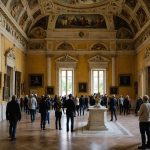Dartmoor's ancient landscape is a treasure trove of Bronze Age artifacts waiting to be discovered. Unlock the mysteries of this fascinating period by organizing a memorable historical tour. From iconic stone circles to burial mounds, Dartmoor offers a unique glimpse into prehistoric life. This guide provides essential tips for experiencing the rich heritage of the region, ensuring visitors connect with the past while enjoying the rugged beauty of the moors. Embrace the adventure and enrich your understanding of Dartmoor's Bronze Age secrets.
Overview of Dartmoor's Bronze Age Significance
Dartmoor, an expanse of rugged moorland in Devon, England, holds a profound historical significance due to its remarkable Bronze Age heritage. This period, spanning approximately 2300 to 800 BCE, marks a time of significant cultural and technological advancements. Dartmoor's landscape is dotted with numerous prehistoric monuments and settlements, offering a rich tapestry of archaeological heritage that captivates historians and archaeologists alike.
Also to see : Discover Coastal Wonders: Join a Guided Kayaking Adventure Through Pembrokeshire”s Enchanting Caves!
The archaeological significance of Dartmoor lies in its extensive and well-preserved remains from the Bronze Age. These include stone circles, burial mounds, and hut circles, providing invaluable insights into the lives of ancient communities. The prehistoric sites on Dartmoor are among the best-preserved in Europe, offering a unique window into the social and ritual practices of the time.
Key archaeological findings, such as the Grimspound settlement, reveal sophisticated construction techniques and community organisation. This site, with its stone enclosures and roundhouses, exemplifies the architectural ingenuity of Bronze Age inhabitants. Additionally, the numerous cairns and standing stones scattered across the moor underscore the area's ritualistic and ceremonial importance.
Also to discover : Top UK Destinations for Spectacular Starling Murmurations: Where to Witness Nature”s Dazzling Display
Dartmoor's Bronze Age legacy is not only a testament to the archaeological heritage of the region but also a vital resource for understanding prehistoric Britain. Its preservation and study continue to enrich our knowledge of early human civilisation.
Tour Options for Exploring Dartmoor
Exploring Dartmoor's Bronze Age heritage can be an enriching experience, and there are several tour options available to suit different preferences. Visitors can choose between guided tours and self-guided tours, each offering unique benefits.
Guided Tours
Guided tours provide an in-depth exploration of Dartmoor's archaeological sites with expert insights. These tours are often led by knowledgeable guides who offer detailed explanations of the historical significance of sites like Grimspound and various stone circles. Recommended companies for guided experiences include Dartmoor Walks This Way and Legendary Dartmoor Tours, both known for their engaging storytelling and comprehensive itineraries.
Self-Guided Tours
For those who prefer a more flexible approach, self-guided tours allow visitors to explore at their own pace. These tours can be supported by detailed maps and audio guides, which are available from local visitor centres. This option is ideal for those who enjoy setting their own schedule and delving into the landscape independently.
Seasonal Considerations
When planning a tour, it's important to consider the seasonal weather conditions on Dartmoor. The moorland can be challenging during winter months, with fog and rain impacting visibility. Therefore, spring and summer are recommended for a more pleasant experience, ensuring that the beauty and history of Dartmoor can be fully appreciated.
Key Archaeological Sites to Visit
Exploring Dartmoor's archaeological sites offers a captivating journey into the past, where prehistoric monuments tell stories of ancient civilisations.
Stone Circles
Among the most intriguing Dartmoor sites are the stone circles, such as the Scorhill and Grey Wethers. These prehistoric monuments are believed to have served ceremonial or astronomical purposes, though their exact function remains a subject of debate. The alignment of stones may have been used to mark important celestial events, offering insights into the astronomical knowledge of Bronze Age communities.
Cairns and Barrows
Dartmoor is also home to numerous cairns and barrows, which are ancient burial sites. These structures, often found on hilltops, contain burial cairns that provide crucial information about the funerary practices of the time. Artefacts discovered within these sites, such as pottery and tools, shed light on the social and cultural aspects of Bronze Age life.
Settlement Remains
Settlement remains, like those at Grimspound, highlight the importance of settlement sites in understanding community life during the Bronze Age. Visitors can explore the remnants of roundhouses and stone enclosures, gaining a glimpse into the daily lives and organisational skills of ancient inhabitants. These sites offer a tangible connection to the past, revealing the architectural and social ingenuity of early societies.
Itineraries for a Historical Tour
Planning a journey through Dartmoor’s Bronze Age heritage can be both exciting and rewarding. Whether you are considering a day trip or a longer stay, careful travel planning will enhance your experience.
Suggested Itineraries
For a one-day tour, begin your adventure at the iconic Grimspound settlement. Here, explore the roundhouses and stone enclosures that showcase the architectural prowess of ancient communities. Next, head to the Scorhill Stone Circle, where the alignment of stones offers a glimpse into prehistoric astronomical practices. Conclude your day with a visit to a burial cairn, providing insights into the funerary customs of the era.
For those opting for a multi-day itinerary, extend your exploration to include the Grey Wethers Stone Circle and various cairns and barrows scattered across the moor. Dedicate time to wander through the remains of settlements, such as those found at Grimspound, to gain a deeper understanding of Bronze Age life.
Tips for Maximizing the Experience
- Early Start: Begin your day early to avoid crowds and enjoy the tranquillity of the moor.
- Guides: Consider hiring a local guide for richer insights into the sites.
- Weather Preparedness: Be prepared for changing weather conditions to fully appreciate the beauty and history of Dartmoor.
Engaging with Local Guides and Experts
Exploring Dartmoor's Bronze Age sites can be greatly enriched by engaging with local guides who offer expert insights and a deeper understanding of the area's historical context. These guides are invaluable for uncovering the stories behind the ancient monuments and settlements scattered across the moor.
One of the primary benefits of hiring local guides is their intimate knowledge of the landscape and its history. They can provide detailed explanations and answer questions with precision, enhancing your appreciation of the sites. Guides such as those from Dartmoor Walks This Way specialise in storytelling that brings the past to life, while Legendary Dartmoor Tours is renowned for its comprehensive itineraries that cover significant archaeological sites.
To prepare for a guided experience, consider the following:
- Research: Look into the specialties of different guides to find one that aligns with your interests.
- Communication: Contact guides in advance to discuss your expectations and any specific sites you wish to visit.
- Comfort: Dress appropriately for the weather and terrain to ensure a comfortable exploration.
By choosing to explore with local experts, you gain access to a wealth of knowledge that transforms your visit into a captivating journey through Dartmoor's ancient past.
Tips for Organizing an Enriching Tour
Planning an enriching tour of Dartmoor's Bronze Age heritage requires careful consideration and preparation. Understanding the best times to visit is crucial. Spring and summer are ideal, offering both pleasant weather and longer daylight hours for exploration. Avoid winter months when fog and rain can obscure visibility and make navigation challenging.
Proper visitor preparation enhances the experience significantly. Ensure you bring essentials such as sturdy walking boots, a waterproof jacket, and a detailed map of the area. These items will help you navigate the rugged terrain comfortably and safely. Additionally, packing a camera is advisable to capture the stunning landscapes and ancient sites.
For those seeking comprehensive tour planning tips, several resources are available. Local visitor centres offer maps and guides, while online platforms provide detailed itineraries and historical context. Engaging with these resources can enrich your understanding of Dartmoor's archaeological significance and assist in crafting a well-rounded visit.
Consider these travel advice points to ensure a rewarding journey: start early to avoid crowds, check weather forecasts in advance, and remain flexible with your plans to accommodate any unforeseen changes. With thoughtful preparation, your exploration of Dartmoor's ancient past will be both memorable and insightful.
















